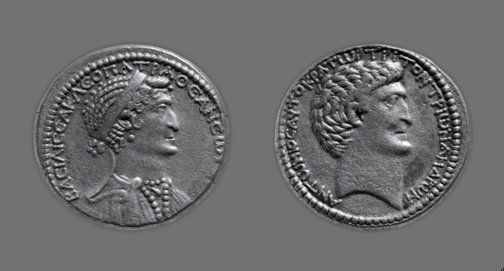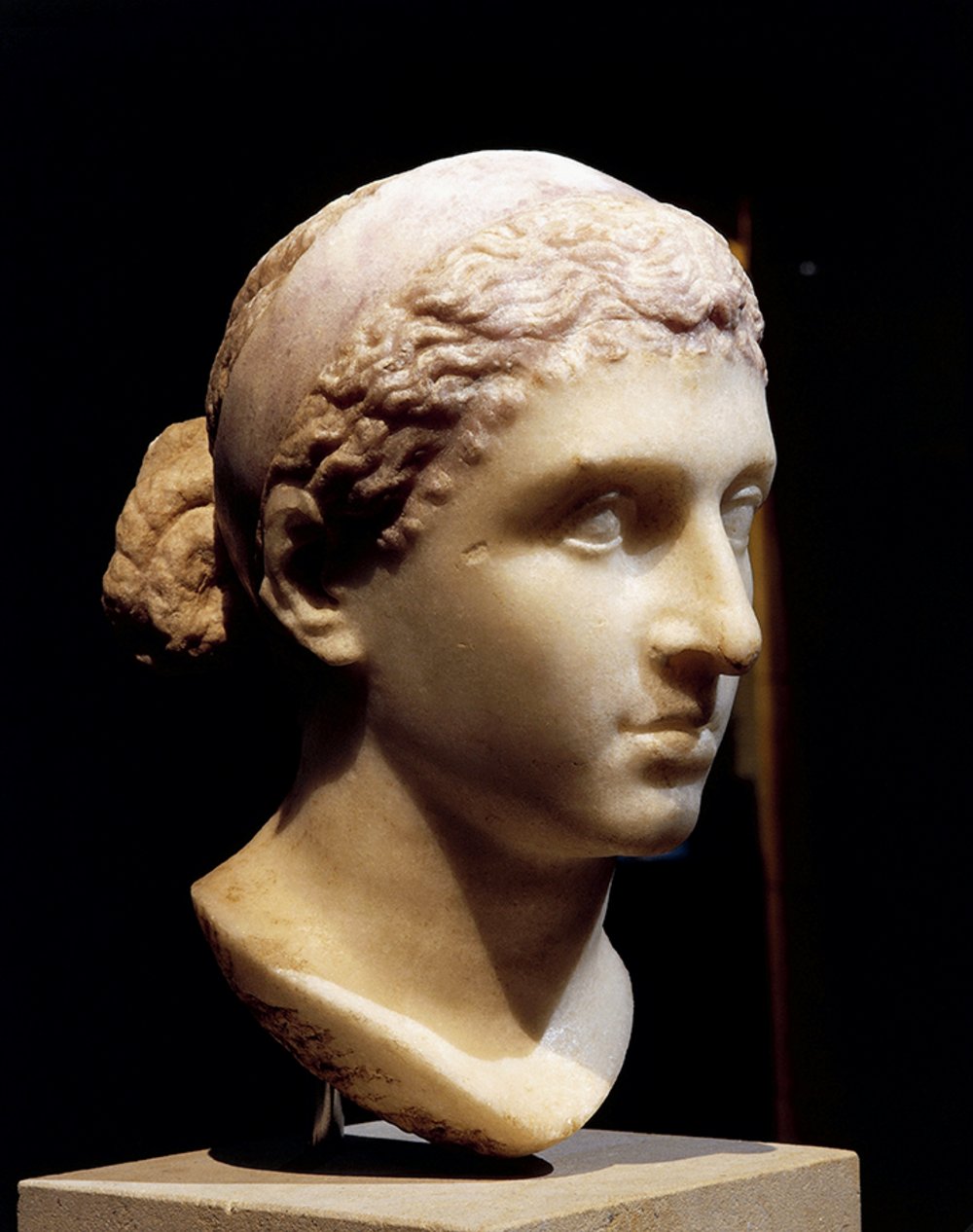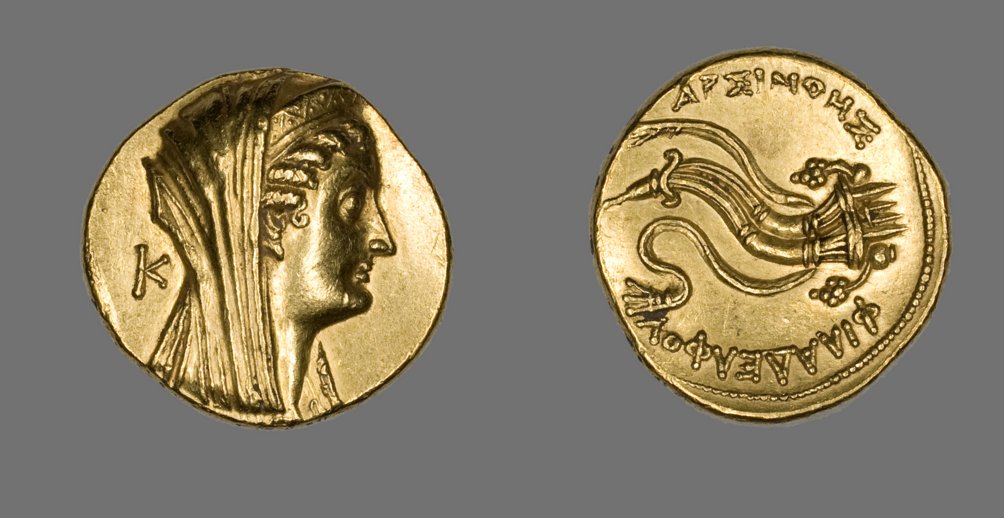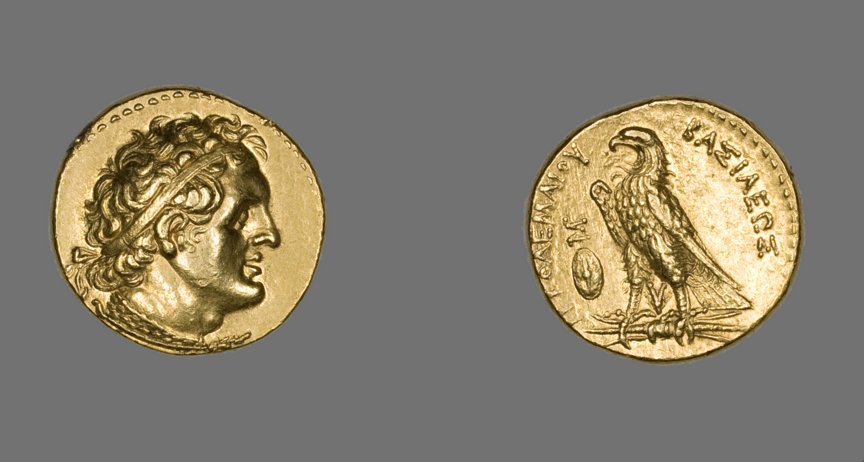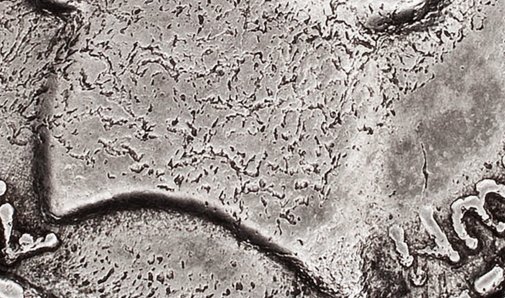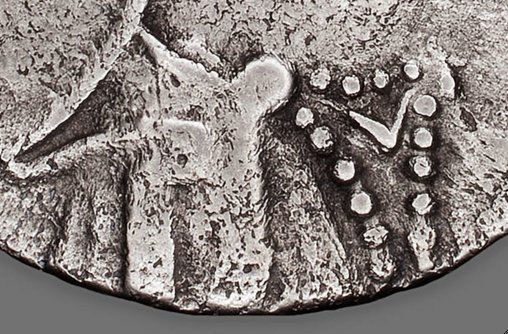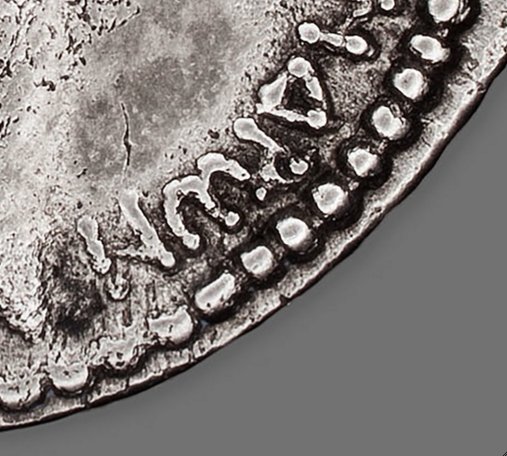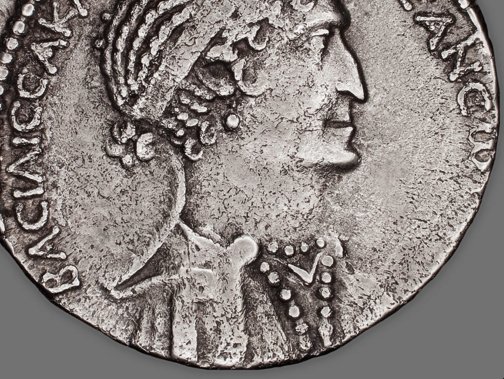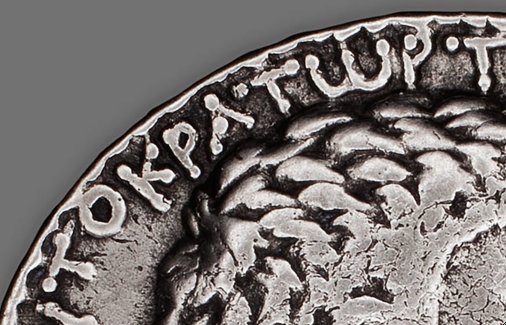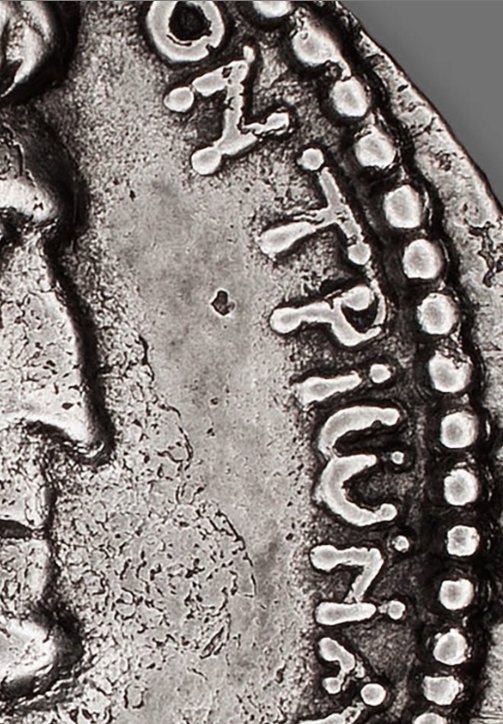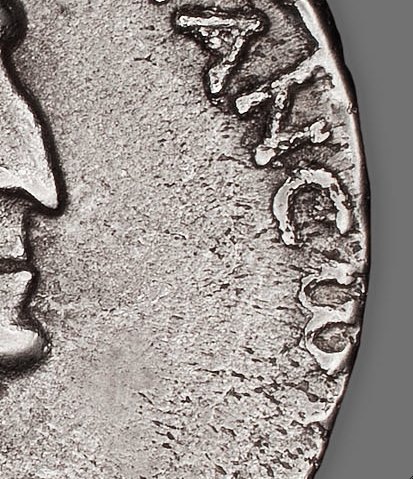It is indicative of the nature of Roman civilization that this catalogue of Roman coins should include this coin, the denomination and language of which are not Roman. Issued by Mark Antony in partnership with Cleopatra VII, this tetradrachm speaks of her wide-ranging and daring plan to create a new Egyptian empire in the East, aided by the power of Rome. The greatest risk of the undertaking was that control within Rome was being contested and Cleopatra needed to choose the winning side in order to succeed—and survive.
The creation of the triumvirate of Mark Antony, Octavian Caesar, and Lepidus in 43 B.C. transformed the nature of the Roman Republic, but it was not yet clear how—or from where—the new Rome would be ruled. The “Liberators” Brutus and Cassius, the assassins of Julius Caesar, had established themselves in Rome’s eastern provinces, but they did not manage to get the backing of Egypt’s ruler (and Julius Caesar’s lover), Cleopatra VII. The triumvirate’s first order of business was thus to recover the East and keep the wealth of Egypt within reach of Rome, while Cleopatra needed to dexterously manage the interests of Rome in order to keep her siblings and other potential rivals at bay and to secure the independent future of Egypt.
After the battle of Philippi (42 B.C.) sealed the doom of the Liberators, Antony claimed the East as his responsibility and his power base. Already tensions with Octavian had pushed Antony to strive for a spectacular and definitive victory that would solidify his support among the Senate and the people of Rome. His ambitious goal was to reconquer Parthia; for that he needed the strategic support of Egypt. For her part, Cleopatra planned to use the divisions within Rome for her own purpose: to restore the ancient extent of the Ptolemaic empire, which once had stretched from Cyrene to southern Asia Minor. After Philippi the triumvir and the queen met in Tarsus to discuss their collaboration. Antony tracked down and executed Cleopatra’s sister (and rival) Arsinoë; Cleopatra bore Antony twins. It was four years before their paths crossed again.
As relations with Octavian deteriorated and his own military efforts remained underwhelming, Antony was desperate for money and ships. In 37 B.C., though not yet divorced from Octavia, he and Cleopatra wed in a union recognized in Greek lands but not in Rome. A costly and inconclusive military campaign in Parthia was followed by a modest victory in Armenia, which Cleopatra and Antony celebrated in 34 B.C. as a “triumph” in Alexandria. During this victory celebration—an imitation of the Roman triumphs, which were the prerogative of the Senate to bestow—Antony, Cleopatra, and Cleopatra’s four children dressed as Hellenistic Egyptian deities. Antony had already been hailed in Athens as the New Dionysos, and he reprised the role here, assimilated to Osiris. Cleopatra assumed her traditional role of Isis, and their twins, Alexander Helios and Cleopatra Selene, appeared as the Sun and the Moon. Their youngest son, Ptolemy Philadelphus, just two years old, was dressed as one of the Diadochoi, the successors of Alexander, according to Plutarch. Cleopatra’s eldest son, Ptolemy Caesar, called Caesarion, was promoted as the son and rightful heir of Julius Caesar. Here the clear implication was that Antony’s rival Octavian, the posthumously adopted son of Julius Caesar, was an impious usurper, and that the wealth and political capital he claimed to inherit justly belonged to Caesarion, Julius Caesar’s natural son. Antony in this way could pose as the real protector of Caesarion, surely hoping to curry favor with Romans. As Roman consul and triumvir, Antony then declared Cleopatra to be Queen of Kings of the eastern regions and her children Kings of Kings. This, in contrast, was not going to enchant the Romans, but Antony needed Cleopatra. In this Donation of Alexandria, Antony claimed to restore Ptolemaic rule over large parts of former Roman provinces, from Cyrene to Parthia and Armenia, as well as some neighboring kingdoms. Antony’s authority to so bestow these lands was rather shaky. Underscoring the weakness of his situation is the fact that although he was the consort of the queen and the father of three of her children, Antony did not enjoy an official position in the Donation or elsewhere in the power structure Cleopatra foresaw for Egypt.
The Donation of Alexandria was a great shock to Rome, and shortly afterward, in 32 B.C., the public scandal of Antony’s divorce from the long-suffering Octavia lost Antony the rest of Rome’s dwindling support. Back in Rome, Octavian read Antony’s purported will in the Senate, letting it be known to the public that Antony was willing to allow himself, and Rome, be ruled by a woman—and a foreign woman at that. This final breach between the two former allies led to the battle of Actium the following year, the deaths of Antony and Cleopatra, and the gradual creation of the principate. Though the Republic was not officially pronounced dead (indeed, Octavian would claim to restore the Republic), from this point on Rome would essentially be ruled not by an elected senate but by a prince (princeps, chief). For Cleopatra and Egypt, it meant the end of more than 350 years of Ptolemaic rule, as well as the end of her brilliant and storied life.
This coin gives no indication of mint, though several active mints in Syria are possible sources; from there, the coins may have circulated freely in Rome’s eastern provinces. The date is equally vague since the reference to Antony’s third acclamation as imperator only narrows it down to 38–32 B.C.; the lack of Cleopatra’s eventual title Queen of Kings may suggest that the coin is earlier than the Donation of Alexandria of 34 B.C.
A particular fascination of this coin lies in the way that it reflects the complex manipulations and redefinitions of cultural and political identity during these years. It is useful to compare this tetradrachm to other coins minted by Antony and his rivals at this time. Double-headed types had appeared recently in some issues (denarii and tetradrachms) of the triumvirs and others who thought they might have a chance at ruling Rome. These two-headed coins articulated political and cultural associations as well as dynastic relationships of the individuals depicted on the coins. An earlier tetradrachm of Antony and his wife Octavia from Ephesus (possibly), included in this catalogue, shows how this worked: while the denomination (tetradrachm) and cultural referent (Dionysian Mysteries) are local and seem to celebrate Rome’s appreciation of the culture and religion of the Hellenistic East, the coin also trumpeted Antony’s collaboration with Octavian (sealed by his marriage to Octavian’s sister) and announced Antony’s official Roman titles in Latin (in the nominative case, as is usual on Roman coins). Curiously, the coin is minted backward by local standards: on civic tetradrachms of the Hellenistic East, the issuing authority should appear on the reverse of the coin. But Antony’s portrait is here on the obverse, and Octavia’s on the reverse. Certainly Octavia did not issue this coin: perhaps the layout reflects Roman cultural norms of male dominance and the perceived reality of Rome’s political and military dominance over the East. At any rate, the authority of Rome is strongly in evidence.
The present tetradrachm was also meant to circulate in the same areas where the earlier coins of Antony did—areas that had once been part of the Ptolemaic empire. Antony was in desperate need of money to pay for the Parthian campaign. Cleopatra joined Antony in Antioch in 37–36 B.C., supplying him with the funds he needed; this coin was issued to pay his troops and suppliers, and perhaps also to celebrate the marriage, which probably took place at this time. Cleopatra’s head is here on the obverse, and this time the inscription is in Greek, not Latin. Antony officially still held imperium over Rome’s eastern provinces, a power that gave him authority over the mints. Therefore his portrait and his titles are properly on the reverse of the coin—the normal place where the issuing authority is identified on provincial coinage. Cleopatra is honored on the obverse, but is not the issuing authority. Yet it is interesting to ponder how this coin would be read by those into whose hands it fell. Would locals and Roman soldiers assume that Cleopatra was now Antony’s equal—or even his superior? Would they recognize the legal subtlety of the declaration of Rome’s authority on the reverse, or would they assume that Cleopatra was the “head” in power?
The Greek inscriptions on the coin seem straightforward enough, but only add to the ambiguity. To begin with, they reflect a curious creeping of Roman coin production habits. Though the inscriptions on both sides are in Greek, they are both in the nominative case, simply naming the individuals represented on the coin, and they are written around the periphery of the coin. This is typical of Roman coins. Hellenistic coinage was inscribed in the genitive case, proclaiming the coin to be, for example, “of Queen Cleopatra,” and the inscriptions were usually written across the coin either horizontally or vertically or both. The use of Roman-style inscriptions (though Greek in language and script) on both sides of this coin suggests the extent to which it reflects a hybridization of Hellenistic and Roman culture, at least at the numismatic level. But is this a thoughtless combination of styles, or is there a reason for the odd choice?
On the reverse we find ANTωNIOC (Antonios) AYTOKPATωP TPITON (autocrator triton, imperator for the third time) TPIωN ANΔPωN (trion andron, triumvir). The titles, though in Greek, are traditionally Roman, bestowed by the Senate, and constitute the authority by which he could mint coins. There is no mention of any royal claims or local honorifics, such as identification as the New Dionysos, an honor given to Antony in Athens and Ephesus. The inscription, however, is in the nominative case, as is typical of Roman coins, instead of in the genitive, which would recognize the authority issuing a Greek coin. The effect of this is that Antony is simply identified here, rather than identified as the actual issuing authority—a subtlety that may or may not have been lost on all but the mint officials involved. The unobjectionable titles are accompanied by a modest lack of any visual claims of power, such as laurel or oak wreaths.
The obverse is even more cryptic: BACIΛICCA KΛEOΠATPA ΘEA NEωTEPA. This could be read as identifying Queen (Basilissa) Cleopatra as the “younger goddess” (Thea Neotera), though exactly to whom this cult might refer is unclear. Cleopatra’s long-established identification with the goddess Isis was already strong and politically useful, so any benefits of an identification with an unnamed goddess are equally mysterious. More likely, the title is evidence that the queen of Egypt was engineering a careful reinvention of herself as the new incarnation of her ancestress Cleopatra Thea, who as wife of three Seleucid kings became the Ptolemaic queen of Syria from 125 to 121 B.C. This interpretation is reinforced by the fact that other coins of Cleopatra in Syria and Phoenicia that indicate the year of issue use a different dating system from that used in Egypt: this dating era begins with Antony’s grant of Syrian lands to Cleopatra in 37 B.C. Together, this evidence points to Cleopatra’s aims to combine the dynastic claims of two successors of Alexander the Great—Ptolemy and Seleucus—and to renew the Egyptian Empire. In contradistinction to Antony’s portrait, Cleopatra is not depicted bareheaded. She wears the royal diadem, as worn by the successors of Alexander the Great. Antony may have had the authority to mint this coin, but the power and the wealth were Cleopatra’s. This coin seems to telegraph the realpolitik of the situation.
Visually, the impact of the two portraits takes a moment to sink in. The popular press today occasionally finds an opportunity to note that the famous seductress Cleopatra must have been “no beauty queen” and that her allure must rather have been due to her intelligence, charm, and perhaps some less innocent attractions. However, Cleopatra’s portrait on this coin, as well as Antony’s, is consistent with the other evidence: she is on a mission to identify herself as the rightful heir of the great Ptolemaic dynasty. Understanding and even identifying the portraiture of the Ptolemaic queens is fraught with difficulties, since the function of the image; the relative influences of Hellenistic, Roman, and Egyptian art; and deliberate archaism all conspire to present images of the ruler that may not bear much semblance to the ruler herself. This is, of course, completely apart from the loaded, subjective, and culturally conditioned question of what constitutes female beauty.
Cleopatra’s portraits on her coins (or coins minted for her, such as this one) show different views of the queen, just as Antony’s portraits vary over time and from region to region. While sculptures identified as Cleopatra seem generally to reflect either a hieratic Egyptian or a Hellenistic, idealized image, the coin images seem to show almost a different woman (see fig. 22.1). On this coin, her strongly aquiline nose, powerful neck, and heavy brow signal a nearly masculine power and seriousness, while the elaborate, bejeweled garment she wears and the pendant pearl earring announce her royal magnificence. It is natural to want to know which image is more “real,” the softer Hellenized images or this coin portrait with its apparently exaggerated features. As with the sculpted portraits, and for much the same reasons, the question is not simple. On this coin, the striking similarity of the obverse and reverse portraits may present a clue. Antony’s portrait resembles other images of him just enough to be recognizable, just as Cleopatra’s differs from other images of her, while at the same time the two portraits have grown remarkably similar to each other. The visual assimilation of members of a ruling family to each other is a common enough phenomenon, a way to emphasize their harmony, strength, or legitimacy (see, for example, cat. 24, Solidus (Coin) Portraying Emperor Constantine I). The question here is who is being assimilated to whom. Arguments have been made for Cleopatra’s portrait’s being modeled on that of her father, Ptolemy XII Auletes, though again his own public portraits may have been influenced by Roman examples. More convincing on visual and political grounds is the similarity of her portrait to that of Arsinoë II, daughter of Ptolemy I and wife of her own brother, Ptolemy II—and indeed, similarity to their portraits as well (see fig. 22.2 and fig. 22.3). Cleopatra did, on occasion, adopt the double uraeus crown and double cornucopia characteristic of her ancestor Arsinoë, so we know she identified herself with that great queen. The Ptolemy family resemblance is pronounced, and on this coin not only Cleopatra but her consort Antony “sport [the] splendidly beaked noses and protruding chins” so familiar from the faces of her ancestors, the craggy-visaged Macedonian founders of the dynasty and the empire Cleopatra wished to revive.
Sacrificing vanity for power, Cleopatra clearly did not care whether she looked beautiful on the coins (whatever that meant in her world), or even if she looked much like herself. A notable resemblance to her ancestors who ruled the vast eastern lands she now claimed, through the Donation of Alexandria, was more useful. Antony too, as imperator over the region and thus the issuing authority, would have had a say in the depiction of his profile; his likeness is more recognizable on other coinage (such as cat. 31, Denarius (Coin) Portraying Mark Antony) and presumably he acquiesced to this image. Here his artificial resemblance to Cleopatra (and thus to the Ptolemies) is baldly manifest. He must have deemed it politically expedient. Since his position within the Ptolemaic dynasty was so new and unfamiliar, this was a way to visually integrate himself into the royal family in the consciousness of the Syrians. After all, he was no longer merely a triumvir and commander of the Roman armies in the East—he had gambled his future on Egypt and Cleopatra.
Theresa Gross-Diaz
Technical Report
Technical Summary
This coin is made of silver alloyed with a small amount of copper. Additional impurities of lead and gold are also present. The coin was struck with a free-floating reverse, resulting in a die axis of 1:00. Although the coin shows a clear strike, a number of surface features provide clues that the dies used to make the coin—particularly the obverse—had become somewhat worn by the time of striking. The coin is in good condition overall but displays a pitted, veined texture suggesting either that the flan (or blank) was at a relatively low temperature during striking or that the coin was subject to surface enrichment or an overly aggressive cleaning. Minor casting flaws are visible on both the obverse and the reverse faces, and a moderate degree of age-related wear can be seen, particularly on the obverse. During its time in the museum’s collection, the coin has received only one documented treatment.
Structure
Chemical Composition
Primary materials: silver, Ag; copper, Cu
Secondary materials: gold, Au (trace amounts); lead, Pb (trace amounts)
Ancient coins were typically fabricated using gold, silver, electrum (a naturally occurring alloy of gold and silver), and copper alloys. Bullion for the production of coins was obtained principally through mining operations and the collection of surface deposits. The Romans sourced silver and gold from the plentiful veins in Spain, but also used mines in Gaul, Dalmatia, Dacia (in the Carpathian mountains), Britain, the Near East, and Africa. Ores were not the only source of bullion, however: war booty, tariffs paid by other states, stored wealth in the state treasury, and existing coinage could all be melted down and reminted.
The purity of the metal used for minting was highly regulated and carefully overseen. Throughout the Greek and Roman periods, gold coins were particularly refined, usually containing more than 95 percent pure gold. Silver coins had a somewhat smaller but nonetheless impressive degree of purity. For most of Roman history, the purity of the coinage seldom wavered. By the late Imperial period, silver coins had been significantly debased, containing as little as 2.5 percent silver. Even the debasement of coins, however, was closely monitored.
Determining the precise composition of ancient coins is difficult. For a variety of reasons, the surface of a coin is unlikely to be representative of the composition of its interior. While qualitative information can be obtained using minimally invasive methods that analyze the surface of a coin, quantitative results require abrading or removing the surface in order to analyze material closer to the heart metal at the center, an approach that is generally unacceptable in a museum context.
Fabrication
Method
The coin was struck by hand.
Hand striking a coin is performed in three distinct operations: the creation of a flan (or blank), which is the plain lump or disk of metal that receives the image; the creation of a die, which is the stamp used to impress an image on the flan; and the striking of the coin itself.
In order to create flans of a consistent weight and composition, it was first necessary to smelt and refine the bullion. Surviving coins attest to the fact that Roman metalsmiths possessed sufficient knowledge and skill to obtain a high degree of purity and to adjust the alloys to precise specifications. The refined, molten metal was poured into open or two-part clay molds. Gold and silver coins may have been cast in individual molds, but coins could also be cast en chapelet, using open or closed molds connected by channels.
Metal dies were used to impress an image onto the flan. Few ancient official dies survive today: when a die reached the end of its useful life, because of wear or the discontinuation of the design, it was typically destroyed to prevent unauthorized use. Nonetheless, enough evidence remains to conclude that the dies were usually made of a bronze alloy containing a relatively high percentage of tin that could be made sufficiently hard to strike even bronze coins. The vast majority of images on ancient coins are in relief. This means that the images on the dies were carved in intaglio, as a negative image below the metal surface of the die, similar to the way stone seals were cut or engraved, giving a mirror image of what would be displayed on the coin. Also as with stone engraving, the tools were made of iron and would have included punches, burins, chisels, and drills.
Two dies were usually employed in striking a coin. The obverse (lower) die was fixed in position, usually into an anvil or a block of wood. The reverse (upper) die was loose; the image could be engraved directly into the base of a cylindrical or pyramidal piece of metal or, more commonly, into a bronze disk that was fitted into an iron punch or collar. The obverse die was used to stamp the more important side of the coin, which often displayed deeper or more intricate images. Its protected position in the anvil gave a better chance of a clean impression.
The life-span of a die depended on a number of factors: the composition of the metal, the size of the die, the depth of the relief, and the number of coins made. The obverse die wore down less quickly than the reverse die, which was struck repeatedly with a hammer. Dies were sometimes recut or altered for the purpose of changing the inscriptions but also to make repairs to cracks or flaws.
To strike a coin, the minter would put a hot flan (either just cast or reheated) on the lower die, place the upper die above it, and strike the upper die with a hammer, transferring both designs onto the softened metal. A single strike was usually sufficient, but minters sometimes used two strikes. Occasionally a coin will show evidence of multiple strikes in the form of a double or “ghost” image. This is the result of the coin shifting between strikes or the die vibrating out of position.
Evidence of Construction/Fabrication
The coin shows a very good strike, and overall the rendering is extremely distinct. The top of Mark Antony’s hair and his profile are well demarcated and appear in deep relief. The inscription on the reverse is also remarkably clear, with the exception of the final few letters in the bottom proper left quadrant (fig. 22.4).
The obverse die exhibits a certain amount of wear, as evidenced by the lack of articulation in Cleopatra’s garment and jewels (fig. 22.5). There is a gradual loss of relief toward one edge of the coin that could be related to the angle of the mallet and the subsequent dispersion of force throughout the flan during striking.
The strike was slightly off-center but managed to incorporate all of the edge beading on the reverse with the exception of the top proper right quadrant, where the beading was truncated (fig. 22.6). The beading at the bottom is not as fully articulated as the rest, especially along the inside edge. The obverse is missing all of the beaded detail from a point near the center on the proper left side to about halfway through the bottom proper right quadrant (fig. 22.7). The first and last letters of the inscription have also been truncated and, relative to the rest of the letters, appear in comparatively low relief (see fig. 22.8).
There is a crack on the outside edge that emanates from a small notch located between 9:00 and 10:00 when looking at the obverse face. This crack is the result of mechanical stresses in the microstructure brought on by rapid cooling of the flan after striking.
Die Axis
The coin has a die axis of 1:00.
The earliest coins display considerable variation in the orientation of the obverse relative to the reverse, because the dies were unconnected and the reverse could be rotated freely in the punch. The die axes of very early coins seem to be essentially random. In the Hellenistic and Roman periods, specific die axes appear to have been applied more consistently, with some mints generating coins on which both faces are upright and others producing coins with one face inverted (although misalignments occurred even when a definite orientation was intended). To assist the minters in achieving the correct alignment, dies may have been notched or had protruding elements; it was only late in the Roman period that dies began to be hinged, making the alignment regular.
Artist’s/Fabricator’s Marks
No mint mark is present on this coin.
Numismatic Data
Dimensions
Top to bottom: 26.20 mm
Left to right: 25.00 mm
Top proper left to bottom proper right: 25.83 mm
Top proper right to bottom proper left: 25.86 mm
Thickness at widest point: 4.10 mm
Weight
15.20 g
Condition Summary
The coin is in good condition, although both the obverse and the reverse show significant pitting in the form of winding channels (fig. 22.9). A number of factors could explain this surface texture. Flans were usually reheated prior to being struck; the texture might be a result of the semimolten state of the metal as it came into contact with the cold die. Alternatively, the texture might have been caused by surface depletion of copper during minting or burial. The pitting could also be a product of the injudicious use of a harsh agent, such as a strong acid or an electrochemical treatment, to remove burial deposits (although it is unlikely to have been caused by chemical cleaning of secondary corrosion that might have occurred subsequent to excavation).
On the reverse, several “islands” of smooth metal can be seen within the veined, pitted metal, in particular between the bridge of the nose and the inscription in the top proper left quadrant (fig. 22.10). This difference in surface texture is likely a secondary effect of whatever caused the pitted surface. There is a large pit in the smooth area in the top proper left quadrant.
Areas of high relief at the center of both portraits exhibit some degree of use-related wear.
Conservation History
In 2013, in preparation for technical imaging and catalogue photography, the coin was cleaned to remove surface oxidation using a very mild abrasive. After cleaning, all residues of the abrasive were removed with the aid of a stereomicroscope, and a protective coating of an acrylic resin was applied to the surface in order to retard future oxidation.
Rachel C. Sabino
Selected References
Numismatica Ars Classica AG, Zurich, Greek, Roman, and Byzantine Coins, sale cat. (Numismatica Ars Classica AG, Apr. 29, 1998), p. 34, lot 335, pl. 26, no. 335.
Art Institute of Chicago, “Acquisitions,” Art Institute of Chicago Annual Report 2007–2008 (Art Institute of Chicago, 2008), p. 31.
Art Institute of Chicago, “Trustees, Officers, and Committees,” Art Institute of Chicago Annual Report 2007–2008 (Art Institute of Chicago, 2008), p. 70 (ill.).
Numismatica Ars Classica AG, Zurich, Auction 45: The Barry Feirstein Collection of Ancient Coins, pt. 4, sale cat. (Numismatica Ars Classica AG, Apr. 2, 2008), p. 22 (ill.), lot 55.
Mary Greuel, “Coin with Portraits of Cleopatra and Mark Antony,” in “Notable Acquisitions at the Art Institute of Chicago,” special issue, Art Institute of Chicago Museum Studies 35, 2 (2009), pp. 34–35 (ill.).
Art Institute of Chicago, “From the Collection,” Member Magazine: Art Institute of Chicago (Mar.–Apr. 2009), p. 29 (ill.).
Karen Manchester, ed., Recasting the Past: Collecting and Presenting Antiquities at the Art Institute of Chicago (Art Institute of Chicago, 2012), pp. 74–75, cat. 14 (ill.); 111.
Elizabeth Hahn Benge, “From Aegina to Andronicus: A Survey of Coinage at the Art Institute of Chicago,” Historia mundi: Le medaglie raccontano la storia, l’arte, la cultura dell’uomo 5 (Jan. 2016), pp. 206 (ill.); 207, fig. 10; 209–10.
